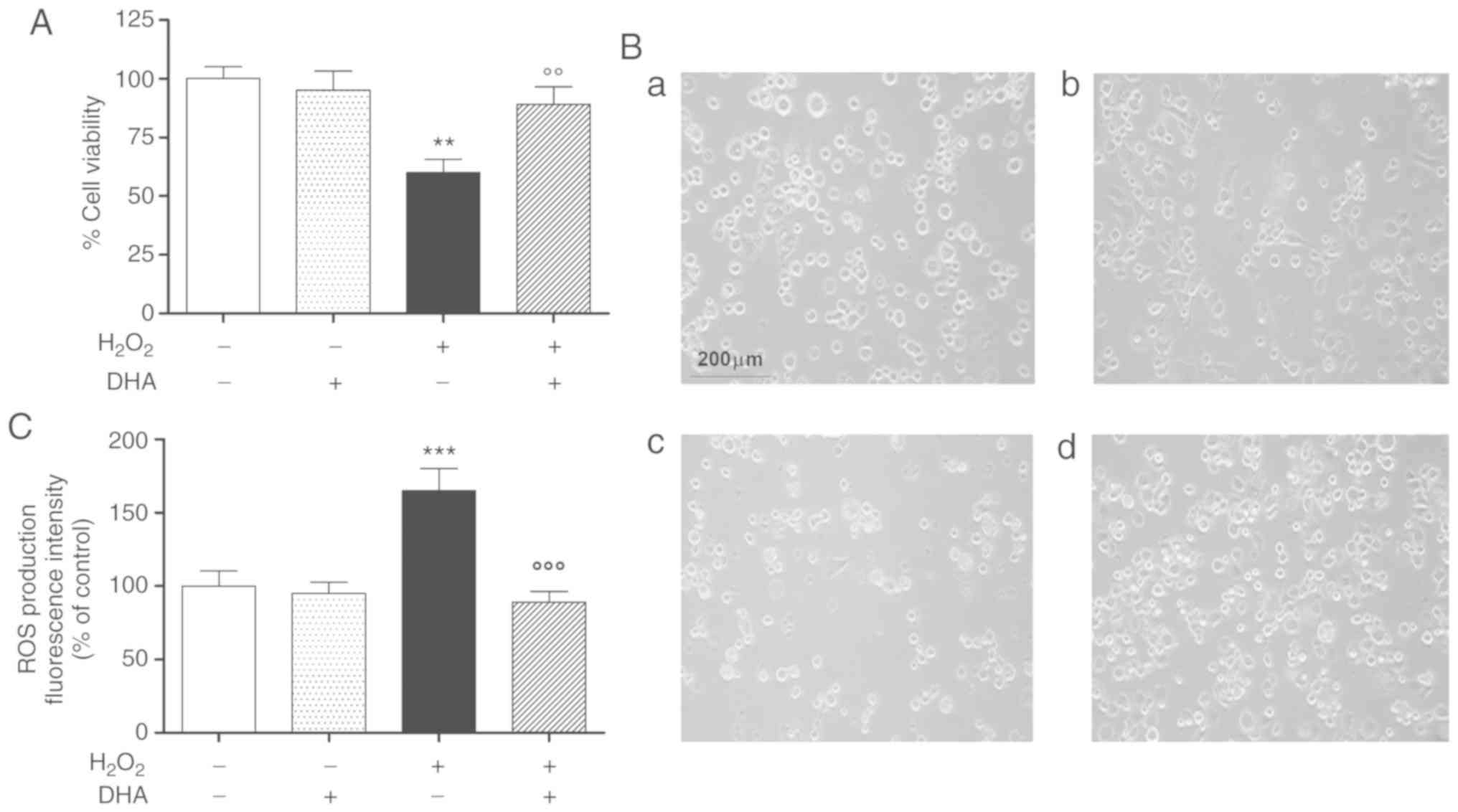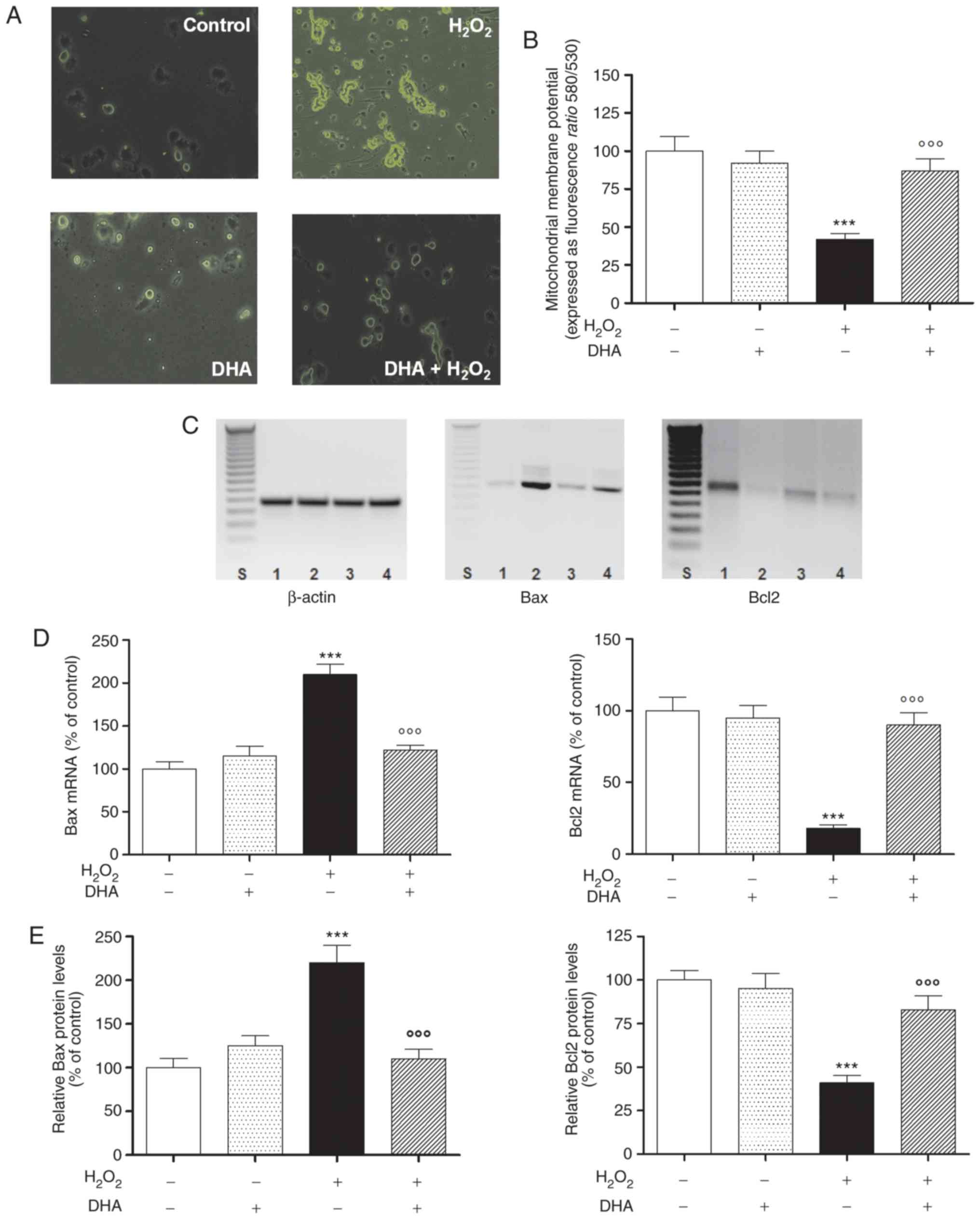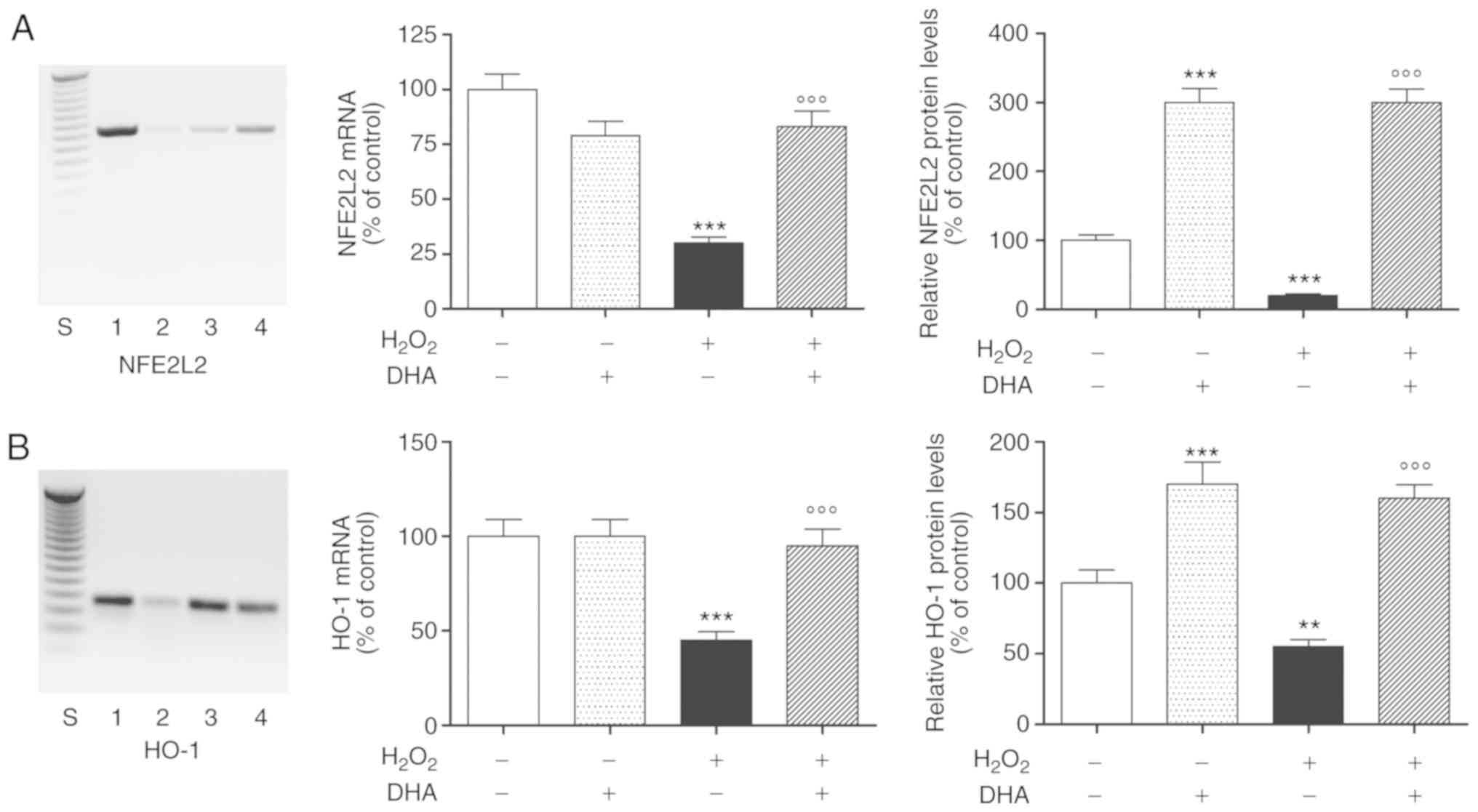|
1
|
Yan MH, Wang X and Zhu X: Mitochondrial
defects and oxidative stress in Alzheimer disease and Parkinson
disease. Free Radic Biol Med. 62:90–101. 2013. View Article : Google Scholar :
|
|
2
|
Cheng YC, Sheen JM, Hu WL and Hun YC:
Polyphenols and oxidative stress in atherosclerosis-related
ischemic heart disease and stroke. Oxid Med Cell Longev.
2017:85264382017. View Article : Google Scholar
|
|
3
|
Li J, O W, Li W, Jiang ZG and Ghanbari HA:
Oxidative stress and neurodegenerative disorders. Int J Mol Sci.
14:24438–24475. 2013. View Article : Google Scholar : PubMed/NCBI
|
|
4
|
Shi H, Hudson LG and Liu KJ: Oxidative
stress and apoptosis in metal ion-induced carcinogenesis. Free
Radic Biol Med. 37:582–593. 2004. View Article : Google Scholar : PubMed/NCBI
|
|
5
|
Wysoczański T, Sokoła-Wysoczańska E,
Pękala J, Lochyński S, Czyż K, Bodkowski R, Herbinger G,
Patkowska-Sokoła B and Librowski T: Omega-3 fatty acids and their
role in central nervous system-a review. Curr Med Chem. 23:816–831.
2016. View Article : Google Scholar
|
|
6
|
Miller E, Kaur G, Larsen A, Loh SP,
Linderborg K, Weisinger HS, Turchini GM, Cameron-Smith D and
Sinclair AJ: A short-term n-3 DPA supplementation study in humans.
Eur J Nutr. 52:895–904. 2013. View Article : Google Scholar
|
|
7
|
Siegel G and Ermilov E: Omega-3 fatty
acids: Benefits for cardio-cerebro-vascular diseases.
Atherosclerosis. 225:291–295. 2012. View Article : Google Scholar : PubMed/NCBI
|
|
8
|
Cardoso C, Afonso C and Bandarra NM:
Dietary DHA and health: Cognitive function ageing. Nutr Res Rev.
29:281–294. 2016. View Article : Google Scholar : PubMed/NCBI
|
|
9
|
Wang W, Yang H, Johnson D, Gensler C,
Decker E and Zhang G: Chemistry and biology of ω-3 PUFA
peroxidation-derived compounds. Prostaglandins Other Lipid Mediat.
132:84–91. 2017. View Article : Google Scholar : PubMed/NCBI
|
|
10
|
Smith RE, Tran K, Smith CC, McDonald M,
Shejwalkar P and Hara K: The Role of the Nrf2/ARE antioxidant
system in preventing cardiovascular diseases. Diseases. 4:E342016.
View Article : Google Scholar
|
|
11
|
Vomund S, Schäfer A, Parnham MJ, Brüne B
and von Knethen A: Nrf2, the master regulator of anti-oxidative
responses. Int J Mol Sci. 18:E27722017. View Article : Google Scholar : PubMed/NCBI
|
|
12
|
Dinkova-Kostova AT, Kostov RV and
Kazantsev AG: The role of Nrf2 signaling in counteracting
neurodegenerative diseases. FEBS J. 285:3576–3590. 2018. View Article : Google Scholar : PubMed/NCBI
|
|
13
|
Cong P, Liu Y, Liu N, Zhang Y, Tong C, Shi
L, Liu X, Shi X, Liu Y, Tong Z and Hou M: Cold exposure induced
oxidative stress and apoptosis in the myocardium by inhibiting the
Nrf2-Keap1 signaling pathway. BMC Cardiovasc Disord. 18:362018.
View Article : Google Scholar : PubMed/NCBI
|
|
14
|
Clementi ME, Pani G, Sampaolese B and
Tringali G: Punicalagin reduces H2O2-induced cytotoxicity and
apoptosis in PC12 cells by modulating the levels of reactive oxygen
species. Nutr Neurosci. 21:447–454. 2018. View Article : Google Scholar
|
|
15
|
Lazzarino G, Viola AR, Mulieri L, Rotilio
G and Mavelli I: Prevention by fructose-1,6-bisphosphate of cardiac
oxidative damage induced in mice by subchronic doxorubicin
treatment. Cancer Res. 47:6511–6516. 1987.PubMed/NCBI
|
|
16
|
McCord JM and Fridovich I: Superoxide
dismutase. An enzymic function for erythrocuprein (hemocuprein). J
Biol Chem. 244:6049–6055. 1969.PubMed/NCBI
|
|
17
|
Noble JE: Quantification of protein
concentration using UV absor-bance and coomassie dyes. Methods
Enzymol. 536:17–26. 2014. View Article : Google Scholar
|
|
18
|
Lazzarino G, Amorini AM, Fazzina G,
Vagnozzi R, Signoretti S, Donzelli S, Di Stasio E, Giardina B and
Tavazzi B: Single-sample preparation for simultaneous cellular
redox and energy state determination. Anal Biochem. 322:51–59.
2003. View Article : Google Scholar
|
|
19
|
Amorini AM, Giorlandino C, Longo S, D'Urso
S, Mesoraca A, Santoro ML, Picardi M, Gullotta S, Cignini P,
Lazzarino D, et al: Metabolic profile of amniotic fluid as a
biochemical tool to screen for inborn errors of metabolism and
fetal anomalies. Mol Cell Biochem. 359:205–216. 2012. View Article : Google Scholar
|
|
20
|
Innamorato NG, Rojo AI, García-Yagüe AJ,
Yamamoto M, de Ceballos ML and Cuadrado A: The transcription factor
Nrf2 is a therapeutic target against brain inflammation. J Immunol.
181:680–689. 2008. View Article : Google Scholar : PubMed/NCBI
|
|
21
|
Simopoulos AP: Omega-3 fatty acids in
health and disease and in growth and development. Am J Clin Nutr.
54:438–463. 1991. View Article : Google Scholar : PubMed/NCBI
|
|
22
|
Uauy R and Dangour AD: Nutrition in brain
development and aging: Role of essential fatty acids. Nutr Rev.
64:S24–S33. 2006. View Article : Google Scholar
|
|
23
|
Moore SA: Polyunsaturated fatty acid
synthesis and release by brain-derived cells in vitro. J Mol
Neurosci. 16:195–200. 2001. View Article : Google Scholar : PubMed/NCBI
|
|
24
|
Heras-Sandoval D, Pedraza-Chaverri J and
Pérez-Rojas JM: Role of docosahexaenoic acid in the modulation of
glial cells in Alzheimer's disease. J Neuroinflammation. 13:612016.
View Article : Google Scholar : PubMed/NCBI
|
|
25
|
Molz P and Schröder N: Potential
therapeutic effects of lipoic acid on memory deficits related to
aging and neurodegeneration. Front Pharmacol. 8:8492017. View Article : Google Scholar
|
|
26
|
Yadav RK, Singh M, Roy S, Ansari MN,
Saeedan AS and Kaithwas G: Modulation of oxidative stress response
by flaxseed oil: Role of lipid peroxidation and underlying
mechanisms. Prostaglandins Other Lipid Mediat. 135:21–26. 2018.
View Article : Google Scholar : PubMed/NCBI
|
|
27
|
Sakai C, Ishida M, Ohba H, Yamashita H,
Uchida H, Yoshizumi M and Ishida T: Fish oil omega-3
polyunsaturated fatty acids attenuate oxidative stress-induced DNA
damage in vascular endothelial cells. PLoS One. 12:e01879342017.
View Article : Google Scholar : PubMed/NCBI
|
|
28
|
Matschke V, Theiss C and Matschke J:
Oxidative stress: The lowest common denominator of multiple
diseases. Neural Regen Res. 14:238–241. 2019. View Article : Google Scholar :
|
|
29
|
Jiang S, Deng C, Lv J, Fan C, Hu W, Di S,
Yan X, Ma Z, Liang Z and Yang Y: Nrf2 weaves an elaborate network
of neuroprotection against stroke. Mol Neurobiol. 54:1440–1455.
2017. View Article : Google Scholar
|
|
30
|
Vomhof-Dekrey EE and Picklo MJ Sr: The
Nrf2-antioxidant response element pathway: A target for regulating
energy metabolism. J Nutr Biochem. 23:1201–1206. 2012. View Article : Google Scholar : PubMed/NCBI
|
|
31
|
Frankel D, Mehindate K and Schipper HM:
Role of heme oxygenase-1 in the regulation of manganese superoxide
dismutase gene expression in oxidatively-challenged astroglia. J
Cell Physiol. 185:80–86. 2000. View Article : Google Scholar : PubMed/NCBI
|
|
32
|
Mo L, Yang C, Gu M, Zheng D, Lin L, Wang
X, Lan A, Hu F and Feng J: PI3K/Akt signaling pathway-induced heme
oxygenase-1 upregulation mediates the adaptive cytoprotection of
hydrogen peroxide preconditioning against oxidative injury in PC12
cells. Int J Mol Med. 30:314–320. 2012. View Article : Google Scholar : PubMed/NCBI
|
|
33
|
Giudice A, Arra C and Turco MC: Review of
molecular mechanisms involved in the activation of the Nrf2-ARE
signaling pathway by chemopreventive agents. Methods Mol Biol.
647:37–74. 2010. View Article : Google Scholar : PubMed/NCBI
|
|
34
|
Bellezza I, Giambanco I, Minelli A and
Donato R: Nrf2-Keap1 signaling in oxidative and reductive stress.
Biochim Biophys Acta Mol Cell Res. 1865:721–733. 2018. View Article : Google Scholar : PubMed/NCBI
|
|
35
|
Xu J, Gan S, Li J, Wand DB, Chen Y, Hu X
and Yang GZ: Garcinia xanthochymus extract protects PC12 cells from
H2O2-induced apoptosis through modulation of PI3K/AKT and NRF2/HO-1
pathways. Chin J Nat Med. 15:825–833. 2017.
|
|
36
|
Li M, Xu T, Zhou F, Wang M, Song H, Xiao X
and Lu B: Neuroprotective effects of four phenylethanoid glycosides
on H2O2-induced apoptosis on PC12 Cells via the Nrf2/ARE pathway.
Int J Mol Sci. 19:E11352018. View Article : Google Scholar
|
|
37
|
Fourquet S, Guerois R, Biard D and
Toledano MB: Activation of NRF2 by nitrosative agents and H2O2
involves KEAP1 disulfide formation. J Biol Chem. 285:8463–8471.
2010. View Article : Google Scholar : PubMed/NCBI
|
|
38
|
Cheng J, Wang H, Zhang Z and Liang K:
Stilbene glycoside protects osteoblasts against oxidative damage
via Nrf2/HO-1 and NF-κB signaling pathways. Arch Med Sci.
15:196–203. 2019. View Article : Google Scholar : PubMed/NCBI
|
|
39
|
Maralani MN, Movahedian A and Javanmard
ShH: Antioxidant and cytoprotective effects of L-Serine on human
endothelial cells. Res Pharm Sci. 7:209–215. 2012.PubMed/NCBI
|
|
40
|
Kim HJ and Vaziri ND: Contribution of
impaired NRF2-KEAP1 pathway to oxidative stress and inflammation in
chronic renal failure. Am J Physiol Renal Physiol. 298:F662–F671.
2010. View Article : Google Scholar
|
|
41
|
Liu X, Liu H, Zhai Y, Li Y, Zhu X and
Zhang W: Laminarin protects against hydrogen peroxide-induced
oxidative damage in MRC-5 cells possibly via regulating NRF2. Peer
J. 5:e36422017. View Article : Google Scholar : PubMed/NCBI
|

















